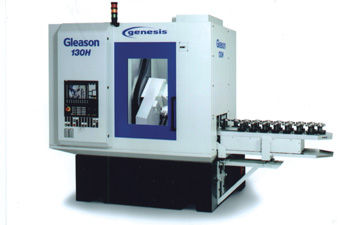Adding Capacity and
Reallocating Resources
The Gleason-Pfauter facility in Ludwigsburg is operating at record-high levels, with assembly underway on dozens of large hobbing, shaping and profile grinding machines, many destined for Hansen Transmissions’ new wind power facility in Tamil Nadu, India. The addition of new assembly floorspace nearby, and a reallocation of resources within Gleason’s global operations on the whole, have made it possible for Gleason-Pfauter to react quickly and effectively to current and future wind power demands.
Introducing New Technology
Many of Gleason’s most recent product and technology innovations can be useful to manufacturers of large gears with complex geometry—typical of wind turbine gears.
• Opti-Cut indexable insert tooling system. Gleason’s new family of gear gashing, shaping and hobbing cutters is equipped with replaceable, indexable insert technology, making it economical for users to apply the latest carbide materials and coatings to operations, such as internal gear gashing, where solid high-speed steel cutters are generally used. With this system, users can run their machines at optimum feeds and speeds, taking precious minutes out of the machining cycle times and ultimately lowering total cost per workpiece.
• Electronic Guide (ES) shaping capability. Where shaping is required, Gleason offers its ES gear shaping machines. The ES technology eliminates the need for mechanical helical guides and the associated expense and long changeover time. ES technology improves productivity through the dramatic reduction in setup changeover time. Gleason’s ES technology uses a proprietary CNC technique to electronically superimpose a twisting motion on the shaper cutter as it rotates. Input parameters, such as helix angle and defining the workpiece, are simply entered into a computer dialogue program, and the CNC controller calculates the necessary controlling motions automatically.
• New profile grinding software. Heat treatment is a vitally important gear processing step for wind power applications because of the need for optimum strength and high reliability. Wind turbine manufacturers have refined and perfected gear design and the associated heat treatment processing to ensure maximum performance under severe operating conditions. Unfortunately the heat treatment process often results in unwanted distortion. This makes finish profile grinding operations critical. Gleason-Pfauter profile grinders employ a suite of software features that can save production cycle time. The Adaptive Process Control software feature reduces the ‘grinding of air’ time typically wasted because the grinding wheel might not actually be making contact with the tooth flank in areas of the gear where heat treat distortion has “moved” the tooth away from its theoretically correct position. Adaptive Process Control detects when there is no contact between the grinding wheel and tooth flank during axial in-feed, and automatically increases the feed rate. This dynamic adjustment of the axial feed rate can reduce overall cycle time on a large gear by several minutes.
Also, an important tooth geometry capability is provided by the software. An anti-twist feature automatically eliminates gear tooth twist to the desired degree. Simple input parameters command the software to achieve this special and exact geometry, which is required in wind turbine applications.
In addition, the software, combined with the control of several machine axes, allows simultaneous grinding of both tooth flanks even though each flank has a different lead and crown. It is difficult to visualize this seemingly impossible capability. As a result, double-flank grinding is being achieved in production and is resulting in reduced cycle times of up to 50%, especially as compared with single-flank grinding.
• Large-gear measurement. With introduction of the Sigma 3000GMM, Gleason has extended its Sigma series of analytical gear inspection systems to meet the needs of the largest gears for wind power applications, and to ‘close the loop’ on quality. Gears up to 3 meters in diameter and weighing up to 9,100kg (20,000 lbs.) can be measured on the Sigma 3000GMM. The Sigma features a new Renishaw SP80H full 3-D scanning probe head, and GAMA Windows-based software to speed and simplify the process. In addition, the Sigma 3000GMM uses a small-grain, high-density granite base for added rigidity and stability.
Offering a Prototype and Pre-Production Jobbing Capability
Underway at Gleason’s Rochester, NY facility is the development of a gear manufacturing capability, designed to assist customers with prototyping and pre-production manufacturing. This capability is designed to help test, perfect and produce gears in short runs for the many new wind turbine programs underway in the U.S. and Canada.
For more information:
Gleason Corp.
1000 University Avenue
Rochester, NY 14692
Phone: (585) 473-1000
Fax: (585) 461-4348
Internet: www.gleason.com






